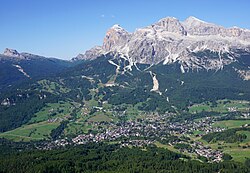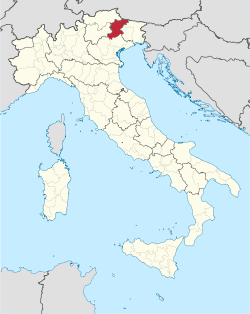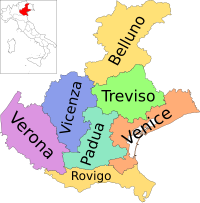|
Province of Belluno
The province of Belluno (Italian: provincia di Belluno; Austrian German: provinz Belluno; Ladin: provinzia de Belum) is a province in the Veneto region of Italy. Its capital is the city of Belluno. It has an area of 3,610 square kilometres (1,390 sq mi) and a population of about 198,000 people. GeographySituated in the Alps, the province of Belluno consists almost entirely of mountainous terrain. It encompasses the natural and historical regions of Cadore, Feltrino, Alpago, Val di Zoldo, Agordino, Comelico and Ampezzano. The province is home to the Dolomites, including Tofane, Marmolada, Tre Cime di Lavaredo, and Antelao. For much of its course, the river Piave, runs through Belluno, as do its affluents the Boite and the Cordevole. The southern part is called Valbelluna, the widest and most populous valley of the province, which is bordered by the Venetian Prealps. The National Park of Belluno Dolomites is located in the province. ClimateThe province of Belluno's climate is among the most severe in the Alps. It is mostly influenced by the continental, provided by the Dolomites and it is very similar to the eastern Tyrol's climate, or even more severe in the Prealps of the southern side. The province may be divided in the following climatic zones:
History
 The oldest archaeological find in the province is that of Lagole di Calalzo, in Cadore, belonging to a c. 5th century BC sanctuary dedicated to a health god of Paleoveneti. A larger site, a necropolis, has been excavated in the commune of Mel. Findings from these sites are now housed in the Museums of Pieve di Cadore and Mel. From the 10th to 12th century the area that became Belluno was part of the March of Verona, a march of the Holy Roman Empire. During the 14th century much of the area came under the control of the Carraresi lords of Padua. In 1404 the Carraresi territories, including Feltre and Belluno, were conquered by the Republic of Venice, becoming part of the Venetian Domini di Terraferma. Cadore in the north also became part of the Domini di Terraferma following the Venetian conquest of Friuli in 1420. In 1511 Maximilian I, Holy Roman Emperor conquered the town of Cortina d'Ampezzo, detaching it from Cadore and incorporating it into the County of Tyrol. Venetian rule lasted until 1797 when Venice was conquered by the French First Republic during the Italian campaigns of the French Revolutionary Wars. Rather than being annexed by France or its satellites, the Venetian territory east of Lake Garda, including Belluno, was ceded to the Habsburg monarchy (Austria) in the Treaty of Campo Formio, thereby becoming the Venetian Province. This state of affairs only lasted until 1805 however, as Austria (the Austrian Empire since 1804) ceded the Venetian Province to the Napoleonic Kingdom of Italy in the Treaty of Pressburg. Within the Kingdom of Italy, modern Belluno roughly corresponded to the Piave department.  After the Napoleonic Wars the former Venetian Province was returned to Austria by the 1815 Congress of Vienna, becoming part of the newly formed Kingdom of Lombardy–Venetia. Under Austrian rule Lombardy–Venetia was organised into provinces roughly corresponding to the Napoleonic departments; the Piave department was succeeded by the province of Belluno, which broadly coincides with the modern province. During the unification of Italy Austria lost Lombardy–Venetia to what became the Kingdom of Italy (the western part (i.e. Lombardy) in 1859, the eastern part (i.e. Venetia and Mantua) including Belluno in 1866). In 1919, following World War I, Italy obtained what had been the southern part of the County of Tyrol from Austria-Hungary: Trentino and South Tyrol. In 1923 Cortina d'Ampezzo, Colle Santa Lucia and Livinallongo del Col di Lana were detached from this territory and added to Belluno. In 1943, when the Italian government signed an armistice with the Allies, the province was occupied by Nazi Germany, which reorganised it (along with the region of Trentino-Südtirol) as the Operation Zone of the Alpine Foothills and put it under the administration of Gauleiter Franz Hofer. The region was de facto annexed to the German Reich until the end of the war. This status ended along with the Nazi regime and Italian rule was restored in 1945. EconomyUntil recently, the province's economy was based on poor mountain agriculture, now less important, with the exception of the cultivation of beans in the Lamon highlands and the production of Piave cheese in the Dolomites valleys. Today, Belluno has one of the most important industrial sectors of northern Italy, the production of eyeglasses (Luxottica originally had its headquarters in Agordo, for example). Also important are the manufacturing sectors of home appliances (Zanussi and others) and bathroom fixtures (Ceramica Dolomite, IdealStandard). One of the most important factors of the Bellunese economy is tourism. Cortina d'Ampezzo, Alleghe, Arabba, Sappada, and other locations are renowned in Italy and abroad. Linguistic minoritiesIn the province, language minorities are present and recognized by law:
Inhabitants with foreign citizenshipThe top ten countries of origin of the inhabitants of Belluno with foreign citizenship at December 31, 2018 were:[2]
ComuniThere are 60 comuni (sg.: comune) in the province. As of December 31, 2018, the main comuni (municipalities) by population are:
References
External linksWikimedia Commons has media related to Province of Belluno.
|
||||||||||||||||||||||||||||||||||||||||||||||||||||||||||||||||||||||||||||||||||||||||




